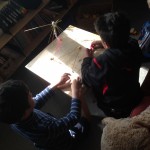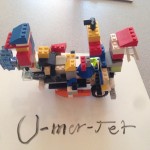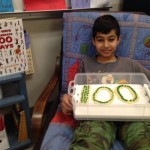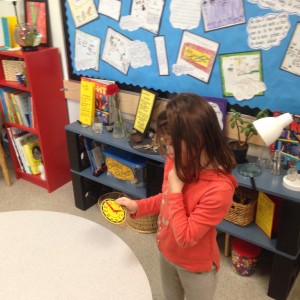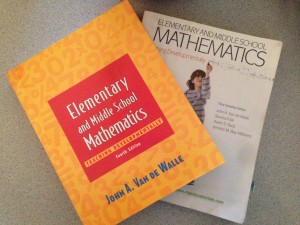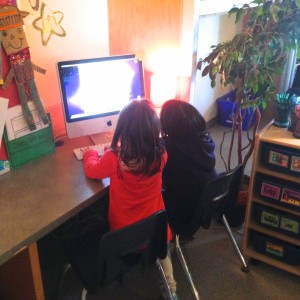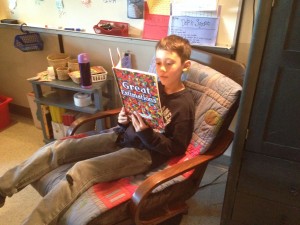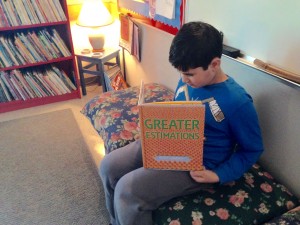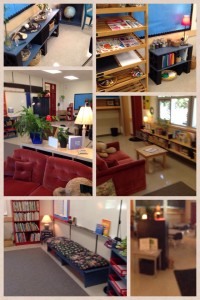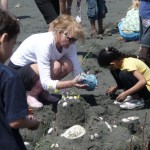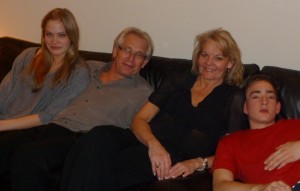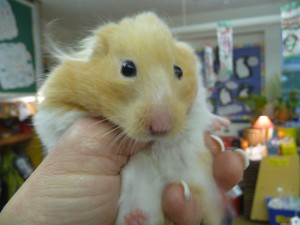It was another wonderful week seeing children meaningfully engaged in thinking, creating, sharing, and communicating their ideas. As we celebrated the arrival of our 100th day, the learning in division 15 was rich and hands-on; not only were there plenty of smiles on the students’ faces, but curiosity, determination, and pride.
The 100th day of school is more than just a milestone worth noting – it’s a rich learning opportunity. Celebrating the 100th day has become a classroom tradition in many schools, especially in the primary grades. Teachers and students in classes all over the province, perhaps the country, celebrate their 100th day at school.
What is the 100th Day of School?
The 100th day of school is literally the 100th day of the school year. From the very first day of school, many classes keep track of the number of days they’ve been in school in anticipation of the 100th day. 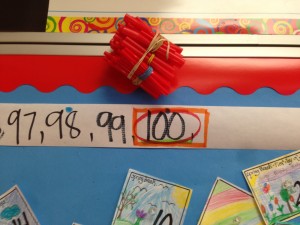 Days are often kept track of by counting straws, or any item for that matter, ten of which become a “ten bundle,” providing ongoing opportunities for counting by tens and ones and developing number and place value concepts.
Days are often kept track of by counting straws, or any item for that matter, ten of which become a “ten bundle,” providing ongoing opportunities for counting by tens and ones and developing number and place value concepts.
By the time a child reaches grade three, he or she has conceivably celebrated three consecutive school years of his or her 100th day at school. These children will have been engaged in developmentally appropriate activities that have them working with the number 100, counting by 100, and making and sharing collections of 100. By the time they enter grade three, children are ready for new challenges.
We began getting ready for our 100th day by reading and listening to Margery Cuyler’s heart-warming picture book, 100th Day Worries.
Our Unique 100 Day Collections
The students were invited to think “outside the box”. We first talked about what this saying means. I asked the children: “Have you ever heard the phrase ‘think outside the box’?” “What do you think it means?” For some this idea was completely new; for others, they could move to discuss its meaning. The children talked about the concept of “thinking outside of the box” and shared their ideas.
“It means you have to look “outside of the box” and try to think of things beyond the obvious.”
“You want us to think imaginatively and come up with a different, unusual, out of the ordinary collection.”
The students seemed to understand the challenge. I wanted them to think of new ideas instead of the traditional or expected ideas. I wanted them to think of a creative or unique way to show100 – something beyond the usual collection of 100 items.
The students were excited about the possibilities and began to brainstorm ideas. I could see that some were still confused and others were ready to take on the challenge. I decided to make this a home project, wanting children to work with their families and enjoy the experience together. An invitation was sent home outlining the criteria. I knew this would challenge some families, but I also knew it would be a welcomed home project. My belief about involving parents in meaningful and enjoyable activities with their children is an important condition in moving a child’s learning forward. My hope was to engage families in rich conversations and work at home. It would be a learning experience not only for the child, but also for his or her family members.
For most, the idea of thinking “outside of the box” was definitely new in the context of the 100 day collection. But the idea or product definitely had some value in a variety of ways and contexts. This task was all about learning. 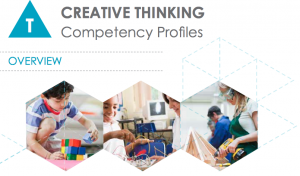 In the BC Ministry’s outline for the Thinking Competency Profiles, it states “The idea or product may also have value in a variety of ways and contexts – it may be fun, it may provide a sense of accomplishment, it may invite problem-solving, it may be a form of self-expression, it may provide a new perspective that influences how people think about something or the actions people take.” This is exactly what it was.
In the BC Ministry’s outline for the Thinking Competency Profiles, it states “The idea or product may also have value in a variety of ways and contexts – it may be fun, it may provide a sense of accomplishment, it may invite problem-solving, it may be a form of self-expression, it may provide a new perspective that influences how people think about something or the actions people take.” This is exactly what it was.
The engagement and success of the children taking on this challenge was impressive. As the week progressed, children were sharing their ideas and the buzz was palpable; they could hardly wait for the day to present their projects. 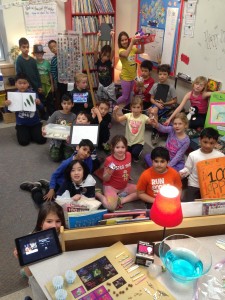
On the day of presenting their “collections” students were also asked to talk about how they came up with their ideas and how they went about putting them together. Everyone’s presentation was captured on video and uploaded on to the child’s digital portfolios on FreshGrade. The Communication Competency profiles were successfully being addressed and met.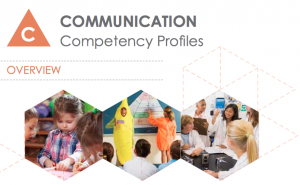
100 Day thinking outside-of-the-box Collections Creating ideas that are novel and new.
Here are some of the students’ “collections”.
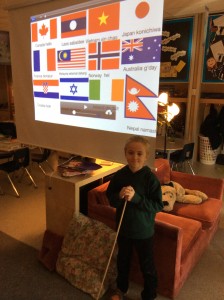
100 Hellos and Flags – Adam shared his video of him saying “hello” in 100 different languages as he pointed to the 100 different country flags.
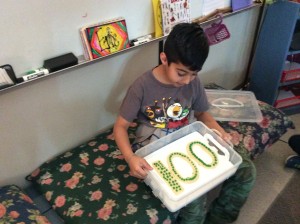
100 Shaped Cookie – Ishan made a cookie out of 100 grams of cookie dough with 100 dots of icing.
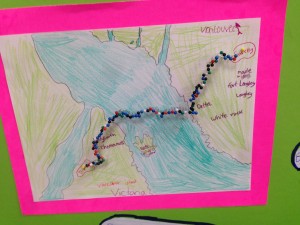
What city is exactly 100 km from my house? – Lauren researched and calculated that the Vancouver Island City of Duncan is 100km away from her house in Surrey. She made a map and showed the routed with coloured pins.

100 Faces – Mirin made a Youtube video of herself making 100 different faces and posted it on her class blog page.

The Karman Line – one of our big buddies shared images on the computer of the Karman line, the imaginary division between the Earth’s atmosphere and outer space, the distant is 100 km above sea.
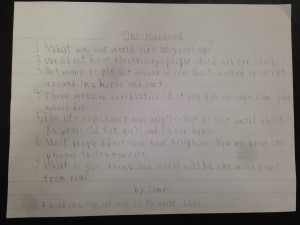
What was our world like 100 years ago? – James described what our world was like 100 years ago using 100 words.
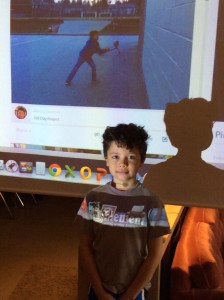 100 Bounces on the Wall – Marcus made a video of himself bouncing a ball 100 times on the school wall.
100 Bounces on the Wall – Marcus made a video of himself bouncing a ball 100 times on the school wall.

100 Second Music Video – Elliot made a video of herself singing and playing the guitar for 100 seconds.

100 Moles of Water – a mole is a unit of measurement used in chemistry. I don’t know if the calculations were accurate, but it sure was interesting.
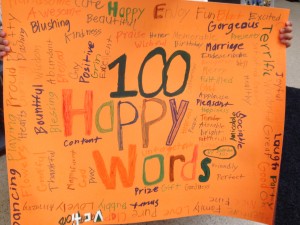
100 Words for Happy – Brayden made a poster with 100 different words that mean “happy” to him.
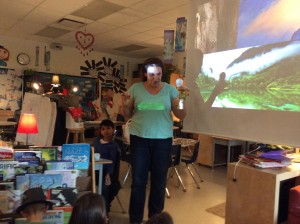
100 Watt Light Bulb – Ms. McClean brought a 100 watt light bulb and challenged our students to some math calculations using the information on the light bulb box, for example, how many 100 watt light bulbs would it take to light 100 days of darkness?
-

-
100 Different Kinds of Leaves
-

-
100 Years in Business
-

-
100 Favourite Things
-

-
100 Battles in 100 Words
-

-
100 Hockey Cards
-

-
100 Googly-Eyed Top Hat
-
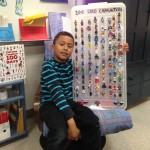
-
100 Lego Characters
-

-
100 Magic Loom Elastics
-
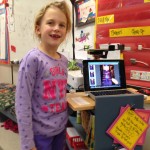
-
100 Photos of Me Growing Up
-

-
100 Special Treasures
-

-
100 Stuffies and Other Stuff
-

-
100 Centimetres on a Metre Stick
Like many rich and meaningful events and experiences that happen in our classroom, the 100th day was a vehicle to invite children to think, communicate, make choices, problem solve, reflect on their strengths and abilities, and feel good about learning and challenging themselves.
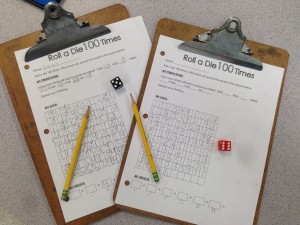
During the week the children also worked on math activities and games that focused on different concepts of the number 100.
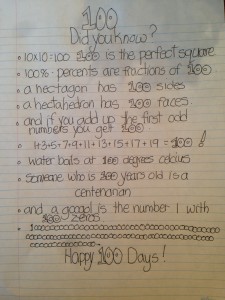
Here are a few other tasks and investigations that we worked on together or that the children could choose to work on alone or with a classmate.
100 Lego Pieces – a building challenge
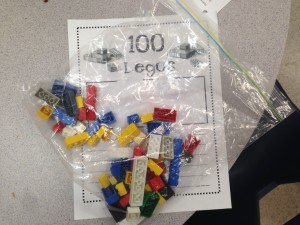 The challenge began with all of us sitting in a circle on the carpet. As I dumped out our 3 large baskets of Lego, the children’s excitement and anticipation was obvious. With bags in hand, children were instructed to count out ten Lego pieces. This process continued in a game like fashion with me asking problem-solving questions and student calculating the multiple of ten answers which directed them to choose their Lego, working to fill their bags with 100 pieces. Once their bags were filled, their task was to use their 100 pieces to build a structure keeping three criteria in mind: the structure had to be one, 100 piece Lego structure which could stand on its own; the structure had to be sturdy so when transported it would not break; once complete, the structure had to be given a name and function.
The challenge began with all of us sitting in a circle on the carpet. As I dumped out our 3 large baskets of Lego, the children’s excitement and anticipation was obvious. With bags in hand, children were instructed to count out ten Lego pieces. This process continued in a game like fashion with me asking problem-solving questions and student calculating the multiple of ten answers which directed them to choose their Lego, working to fill their bags with 100 pieces. Once their bags were filled, their task was to use their 100 pieces to build a structure keeping three criteria in mind: the structure had to be one, 100 piece Lego structure which could stand on its own; the structure had to be sturdy so when transported it would not break; once complete, the structure had to be given a name and function.
As I watched the children working around the room, I noticed some quickly moved to the task. 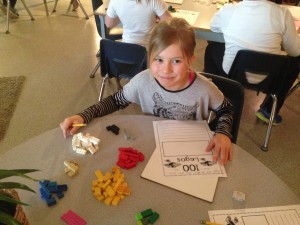 Some began sorting their Legos by colour and size, others just dumped their bag and proceeded to build.
Some began sorting their Legos by colour and size, others just dumped their bag and proceeded to build. 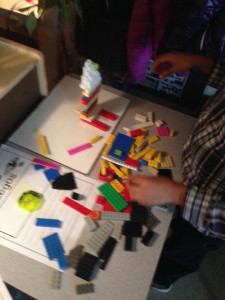 Many carefully focused and constructed their structures; some were simple, others more complex. I noticed two or three students who simply could not get started; they struggled with coming up with an idea and became frustrated with the task. Some built structures that used only a small number of Lego pieces and then wanted to stop; others were tempted to go to the Lego baskets and exchange their pieces.
Many carefully focused and constructed their structures; some were simple, others more complex. I noticed two or three students who simply could not get started; they struggled with coming up with an idea and became frustrated with the task. Some built structures that used only a small number of Lego pieces and then wanted to stop; others were tempted to go to the Lego baskets and exchange their pieces.
Half way through we stopped to debrief and discuss the strategies and challenges students were using and facing. We talked about the qualities that would help someone succeed at such a task: perseverance, not wanting to be perfect, letting go of an idea, making changes, a positive attitude, to name a few. We also talked about professions that require such focus and commitment to solve a problem and work under certain constraints and expectations. Our conversation was relevant and meaningful. Re-energized the students went back to work.
100 year Hopes and Promises
Children discussed and shared their thoughts about some of the challenges, problems, and issues people in our world face today. Some responded to this response task on their blog pages:
In one hundred years what would be your hope for our world, for the people and all living things. In 100 years I hope . . .
. . . there will be no wars and there will be peace in the world and countries will share their creations to make us all equal and have the same opportunities.
. . . that people won’t be homeless.They won’t be hungry and they will have enough money to live like those who do.
. . . that people all around the world think about the Earth and help keep it clean by doing the things that they know can make a difference.
100 Day Investigation
Children worked together using I-pads to research and complete this inquiry task, making lists and charts to share with the class:
Think about. Identify. Write about and illustrate things you can find in our world that are 100 years old or older.
Castles, bridges, Disneyland, turtles, planets, tea bags, escalators, cellophane, instant coffee, windshield wipers, crossword puzzles, parachutes, traffic lights, pyramids, trees, furniture, books, paintings, countries, and people.
Telephones but not televisions. Airplanes but not jets. Movies but not sound or colour. Ovens but not microwaves. Board games but not video games. Phones but not cellphones. Wooden toy blocks but not Lego.
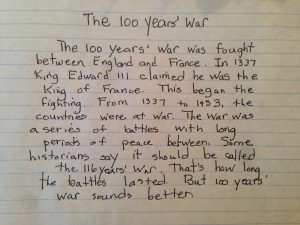 100 Day Poems
100 Day Poems
Some children also chose to write 100 day poems:
Is there a poet inside you? Write a poem to celebrate our 100 days in Div. 15. Be creative. Have some fun with words and images.
Hip, hip, hooray! It’s our 100th day!
Here at school, there’s lots to do.
Crafts to make. Games to play.
Ask a question. Research why?
Design a 100th day I spy?
Roll a dice? Investigate?
Build, or paint, or calculate?
All to 100! Hip, hip, hooray!
Reflections on Our Week
As I reflect on this week’s learning in division 15, our 100 day activities reflected some very important learning intentions and goals. Children explored the world around them and communicated their experiences and ideas through a variety of medium and means. They inquired into topics that interested them, and related to their lives and experiences. Many used technology to present their collections and 100 day tasks.
Students connected and engaged with others, sharing and developing ideas. They acquired, interpreted, and presented information. They collaborated with each other and their families to plan, carry out, and accomplish a goal. Students told about their experiences, reflected on, and shared what they learned. Our week was a success!
As I plan and implement curriculum and work beside young learners, I am always amazed at how able and creative children are when we invite them to explore, create, and think for themselves. Throughout our week, students engaged in informal and structured conversations where they listened, contributed, developed understanding and relationships, and learned to consider diverse perspectives.
I thank our families for helping out and to all my wonderful grade three students and my teaching partner, Ms. McClean, I say, “Bravo! Happy 100th day!”
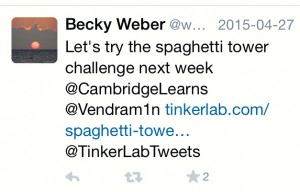 This last Friday, Division 15 participated in Cambridge’s first school-wide Spaghetti Marshmallow Challenge with their big buddy class, Division 2. It all began from a simple tweet sent by Adam’s mom, one of our Cambridge teachers; “Let’s try the spaghetti tower challenge next week”. That’s all it took for Mr. Vendramin and I to begin planning, inviting teachers and classes who were interested to join in; before we could say spaghetti, all 26 divisions, 612 students, were ready to participate.
This last Friday, Division 15 participated in Cambridge’s first school-wide Spaghetti Marshmallow Challenge with their big buddy class, Division 2. It all began from a simple tweet sent by Adam’s mom, one of our Cambridge teachers; “Let’s try the spaghetti tower challenge next week”. That’s all it took for Mr. Vendramin and I to begin planning, inviting teachers and classes who were interested to join in; before we could say spaghetti, all 26 divisions, 612 students, were ready to participate.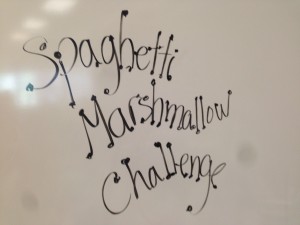 As we prepared for the big event, we started to investigate where this challenge originated. Watching Tom Wujec’s TED Talk, we learned that this Canadian global leader in 3D design and technology began this challenge. In his TED talk he shares the impetus and learning principles behind this learning experience:
As we prepared for the big event, we started to investigate where this challenge originated. Watching Tom Wujec’s TED Talk, we learned that this Canadian global leader in 3D design and technology began this challenge. In his TED talk he shares the impetus and learning principles behind this learning experience: 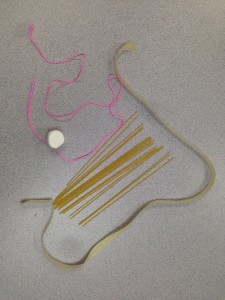 Each group was given a Marshmallow Challenge Kit, which included 20 pieces of dry spaghetti, 1 metre of string, 1 metre of masking tape, and 1 marshmallow. The teams of students were instructed to work together and to apply the very best of their thinking, feeling, and “doing” to the task. Their challenge was to build the tallest structure possible that would support one marshmallow at the top. They had 18 minutes to accomplish this goal.
Each group was given a Marshmallow Challenge Kit, which included 20 pieces of dry spaghetti, 1 metre of string, 1 metre of masking tape, and 1 marshmallow. The teams of students were instructed to work together and to apply the very best of their thinking, feeling, and “doing” to the task. Their challenge was to build the tallest structure possible that would support one marshmallow at the top. They had 18 minutes to accomplish this goal.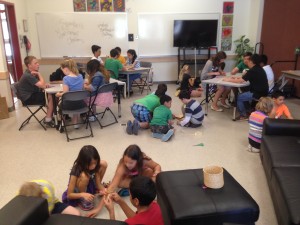 Some groups were quick to learn that they had to test their structures out early, and often, if they were to succeed. This is the mechanism that leads to effective innovation. Others waited until the final minute and their once considered tower of strength became a leaning spaghetti disaster. Students were learning to work together in a shared experience to find a common language and a common stance to build the right prototype in solving a problem. This task challenged students to think creatively and collaboratively to solve a problem as a team.
Some groups were quick to learn that they had to test their structures out early, and often, if they were to succeed. This is the mechanism that leads to effective innovation. Others waited until the final minute and their once considered tower of strength became a leaning spaghetti disaster. Students were learning to work together in a shared experience to find a common language and a common stance to build the right prototype in solving a problem. This task challenged students to think creatively and collaboratively to solve a problem as a team. 











